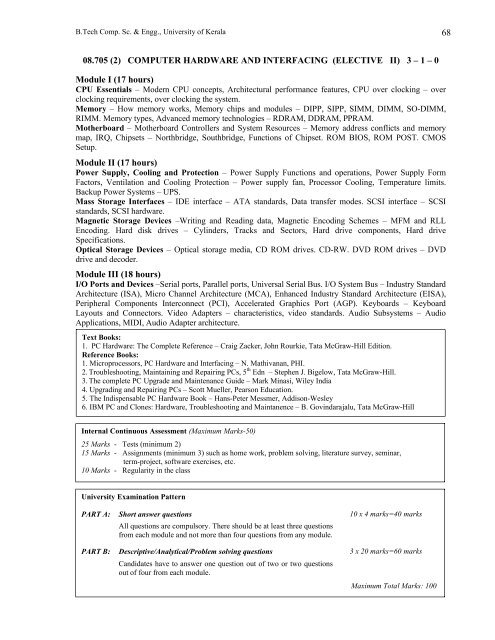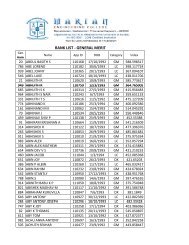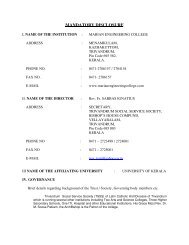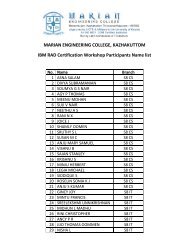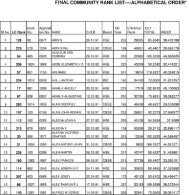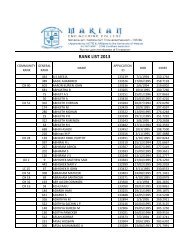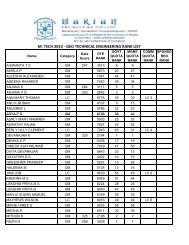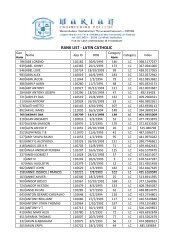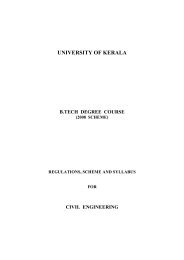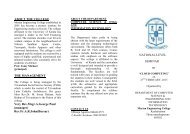UNIVERSITY OF KERALA - Marian Engineering College
UNIVERSITY OF KERALA - Marian Engineering College
UNIVERSITY OF KERALA - Marian Engineering College
Create successful ePaper yourself
Turn your PDF publications into a flip-book with our unique Google optimized e-Paper software.
B.Tech Comp. Sc. & Engg., University of Kerala 68<br />
08.705 (2) COMPUTER HARDWARE AND INTERFACING (ELECTIVE II) 3 – 1 – 0<br />
Module I (17 hours)<br />
CPU Essentials – Modern CPU concepts, Architectural performance features, CPU over clocking – over<br />
clocking requirements, over clocking the system.<br />
Memory – How memory works, Memory chips and modules – DIPP, SIPP, SIMM, DIMM, SO-DIMM,<br />
RIMM. Memory types, Advanced memory technologies – RDRAM, DDRAM, PPRAM.<br />
Motherboard – Motherboard Controllers and System Resources – Memory address conflicts and memory<br />
map, IRQ, Chipsets – Northbridge, Southbridge, Functions of Chipset. ROM BIOS, ROM POST. CMOS<br />
Setup.<br />
Module II (17 hours)<br />
Power Supply, Cooling and Protection – Power Supply Functions and operations, Power Supply Form<br />
Factors, Ventilation and Cooling Protection – Power supply fan, Processor Cooling, Temperature limits.<br />
Backup Power Systems – UPS.<br />
Mass Storage Interfaces – IDE interface – ATA standards, Data transfer modes. SCSI interface – SCSI<br />
standards, SCSI hardware.<br />
Magnetic Storage Devices –Writing and Reading data, Magnetic Encoding Schemes – MFM and RLL<br />
Encoding. Hard disk drives – Cylinders, Tracks and Sectors, Hard drive components, Hard drive<br />
Specifications.<br />
Optical Storage Devices – Optical storage media, CD ROM drives. CD-RW. DVD ROM drives – DVD<br />
drive and decoder.<br />
Module III (18 hours)<br />
I/O Ports and Devices –Serial ports, Parallel ports, Universal Serial Bus. I/O System Bus – Industry Standard<br />
Architecture (ISA), Micro Channel Architecture (MCA), Enhanced Industry Standard Architecture (EISA),<br />
Peripheral Components Interconnect (PCI), Accelerated Graphics Port (AGP). Keyboards – Keyboard<br />
Layouts and Connectors. Video Adapters – characteristics, video standards. Audio Subsystems – Audio<br />
Applications, MIDI, Audio Adapter architecture.<br />
Text Books:<br />
1. PC Hardware: The Complete Reference – Craig Zacker, John Rourkie, Tata McGraw-Hill Edition.<br />
Reference Books:<br />
1. Microprocessors, PC Hardware and Interfacing – N. Mathivanan, PHI.<br />
2. Troubleshooting, Maintaining and Repairing PCs, 5 th Edn – Stephen J. Bigelow, Tata McGraw-Hill.<br />
3. The complete PC Upgrade and Maintenance Guide – Mark Minasi, Wiley India<br />
4. Upgrading and Repairing PCs – Scott Mueller, Pearson Education.<br />
5. The Indispensable PC Hardware Book – Hans-Peter Messmer, Addison-Wesley<br />
6. IBM PC and Clones: Hardware, Troubleshooting and Maintanence – B. Govindarajalu, Tata McGraw-Hill<br />
Internal Continuous Assessment (Maximum Marks-50)<br />
25 Marks - Tests (minimum 2)<br />
15 Marks - Assignments (minimum 3) such as home work, problem solving, literature survey, seminar,<br />
term-project, software exercises, etc.<br />
10 Marks - Regularity in the class<br />
University Examination Pattern<br />
PART A: Short answer questions 10 x 4 marks=40 marks<br />
All questions are compulsory. There should be at least three questions<br />
from each module and not more than four questions from any module.<br />
PART B: Descriptive/Analytical/Problem solving questions 3 x 20 marks=60 marks<br />
Candidates have to answer one question out of two or two questions<br />
out of four from each module.<br />
Maximum Total Marks: 100


